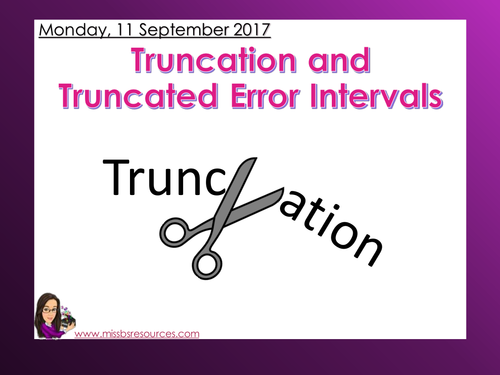

All answers are provided
I've designed this lesson to build up students knowledge of calculating with bounds to find the upper and lower bounds.
It begins with a stopwatch starter where students need to to answer 4 questions based around rounding.
This leads to a brief slide which includes a definition and a basic example about what truncation is for the class to discuss. At this point look at the similarities and differences to rounding. Aka when truncating you always round down.
Truncating Numbers
- 3 examples
- 5 Mini Whiteboard Questions
- Bronze, Silver & Gold Your Turn Section
A class discussion about how we write error intervals and why we use certain inequality notation. This leads to a recap on why 3.4999... would be written as 3.5 with a less than symbol for the upper bound.
Error Intervals
- 3 examples
- 5 Multiple Choice Questions
- Bronze, Silver & Gold Your Turn Section
The resource then in includes a differentiated focused activity which progressively gets harder. This gives students a chance to master and enhance their skills. It includes 3 separate sections: skills 1 and 2 and a stretch. These are all displayed on the same slide for ease of use, however could be printed as a worksheet.
Then to finish there is an application on how this could be seen in an exam situation with 2 exam style questions including answers.
I hope you find this resource as useful as my students have. Any of the the slides could be printed as worksheets if you feel that would be easier for your class.
Miss B
I've designed this lesson to build up students knowledge of calculating with bounds to find the upper and lower bounds.
It begins with a stopwatch starter where students need to to answer 4 questions based around rounding.
This leads to a brief slide which includes a definition and a basic example about what truncation is for the class to discuss. At this point look at the similarities and differences to rounding. Aka when truncating you always round down.
Truncating Numbers
- 3 examples
- 5 Mini Whiteboard Questions
- Bronze, Silver & Gold Your Turn Section
A class discussion about how we write error intervals and why we use certain inequality notation. This leads to a recap on why 3.4999... would be written as 3.5 with a less than symbol for the upper bound.
Error Intervals
- 3 examples
- 5 Multiple Choice Questions
- Bronze, Silver & Gold Your Turn Section
The resource then in includes a differentiated focused activity which progressively gets harder. This gives students a chance to master and enhance their skills. It includes 3 separate sections: skills 1 and 2 and a stretch. These are all displayed on the same slide for ease of use, however could be printed as a worksheet.
Then to finish there is an application on how this could be seen in an exam situation with 2 exam style questions including answers.
I hope you find this resource as useful as my students have. Any of the the slides could be printed as worksheets if you feel that would be easier for your class.
Miss B
Get this resource as part of a bundle and save up to 17%
A bundle is a package of resources grouped together to teach a particular topic, or a series of lessons, in one place.
Something went wrong, please try again later.
This resource hasn't been reviewed yet
To ensure quality for our reviews, only customers who have purchased this resource can review it
Report this resourceto let us know if it violates our terms and conditions.
Our customer service team will review your report and will be in touch.
$9.03